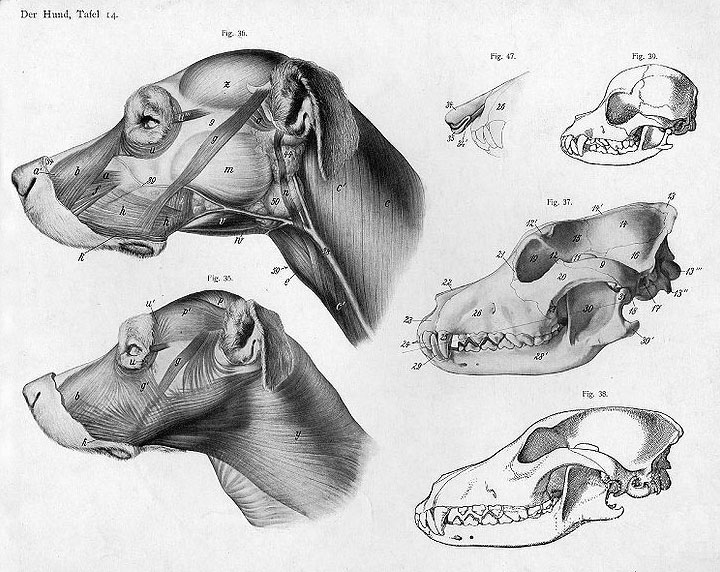Update: 22 November 2024
Canine Care & Feeding
Author: Julie Casper, C. Ac.
Canines suffer from a array of preventable health problems. Biologically incorrect diets, the overuse of vaccinations, pharmaceutical drugs and environmental toxins are the primary causes most of the disease and degeneration found in dogs today.
Contents
- Dogs are Carnivores
- What Not to Feed a Dog
- Commercial Pet Food
- Commercial Pet Food Toxicity
- How Should I Feed My Dog?
- Drinking Water
- Training & Lifestyle Suggestions
- Nutritional Supplements
- hTMA (multipurpose medical screen)
- Resources
Dogs are Carnivores
Your dog's mouth is an evolutionary work of bioengineering excellence. The jaws are hinged and powerful. This design is specific to allow for effective tearing raw meat and crushing bones. A canine's stomach is highly acidic and their saliva lacks amylase. The high acidity facilitates the break down of raw meat, bones, and bacteria. The lack of amylase makes carbohydrate, cellulose and fiber break down and digestion very difficult.

Your dog is anatomically and physiologically designed to eat a carnivorous diet.
Your dog is a carnivore. What this means is that they require muscle and organ meat, bone and fat in their daily diet. For most adult dogs two meals are sufficient. Two meals containing raw muscle and organ meat and ground bone.
Caution Be aware that some types of bones are unsafe for your dog. And most dogs can be enthusiastic eaters, so bone-in meals may pose a risk if they swallow something that's too big. Play it safe and provide a quality ground raw bone product instead. There are good raw feeding suppliers that offer ground meats/organ meats/and ground bone in their mixes. Here is an example:
- Raw Delivery MN — Quality (and affordable) raw food products and treats for your dog.
The most effective way to limit exposure to many environmental poisons and toxins is to make sure that the animal products used in your dog's food are safe. An excellent way to do this is by local sourcing and knowing your meat producer's practices.
Many raw feeders and raw feeding advocates recommend adding vegetables to a canine's diet. Dogs do best on a starch-free, carnivore-type diet. Vegetables provide a multitude of essential vitamins, minerals and roughage for nourishment. Some animals, particularly ruminants and termites, can digest cellulose with the help of symbiotic micro-organisms that live in their guts. Humans can digest cellulose to some extent, however it mainly acts as a hydrophilic bulking agent for feces and is often referred to as ‘dietary fiber.’
Canines are not physiologically designed to eat roughage and carbohydrates. Plant cellulose (fiber) is very difficult to break down without powerful digestive enzymes (specifically amylase) in the saliva, which canines lack. Instead, canines salivate to provide a functional waterside for large chunks of torn flesh and bone to ride into the stomach where they are dissolved for digestion. The challenge of dissolving plant cellulose without a digestion designed to do so can easily cause pH imbalances in a canines stomach, leading to the raw muscle and organ meat sitting in the stomach and small intestine for too long. This causes many problems, from toxicity to digestive enzyme and pH imbalances. Carbohydrates also slow the digestive process. Therefore, if you do have vegetables (plant cellulose) or carbohydrates in your canine's diet, they should be cooked and run through a food processor so they can pass through their digestive system more easily.
A high quality raw bone to clean and sharpen their teeth is recommended for oral hygiene. Be sure that this bone is raw. Cooked bones can splinter and crack into sharp pieces and cause harm. Organic, pasture raised marrow-filled bones are recommended for dogs, and they love them.
Back to TopWhat Not to Feed a Dog
Canine health is compromised by most commercial dog foods that contain grains such as corn, wheat or soy, processed meats and chemical additives and preservatives. Commercial dry and wet food frequently replaces animal protein with grain or vegetable protein; these proteins are not the same, as dogs require meat protein for healthy bodies. Also, the high levels of processing involved in the meat protein used destroy most of the available nutrition. Most commercial foods are laced with preservatives to maintain their long shelf life. Common commercial preservatives in dog foods are BHA, BHT, ethoxyquin, propylene glycol and potassium sorbate. These chemicals contribute to carcinogenicity or tumorigenicity (cancer and tumors). Eating grain-based food will essentially make most dogs sick, inflamed and obese. When fed correctly, dogs are sleek and slim.
The pet food industry is part of the human food and agriculture industry, the tail end to be exact. Pet food is an excellent way to increase profits from what would otherwise be discarded slaughterhouse offal including, heads, hooves, fetuses and udders, as well as diseased and cancerous animal parts, 4D meat (dead, dying, diseased, disabled), animal by-products and grains unfit for human consumption.
Commercial Pet Food
Most commercially produced dry and wet dog foods are inappropriately formulated and use cooked or processed meat. Cooking and processing meat damages the fats and enzymes, as well as many essential nutrients dogs require in their diet. Additionally, most commercial dog food is made with some form of carbohydrate filler, typically a grain. Grains are not a natural food for dogs to consume. The most common grains used are corn, wheat, soy and rice. Dogs cannot digest corn. Wheat, soy and rice are common allergens to dogs, frequently causing inflammation and bloating in their bodies.
Feeding a dog grains compromises their immune system, causing dysfunction over time. Add to this the long list of chemical preservatives, chemical fertilizers, pesticides, herbicide and fungicide residues, and heavy metals particulates from processing machinery. It becomes clear why dogs are suffering from an array of illnesses such as diabetes, skin problems, behavior problems, blindness and various forms of cancer. This can help explain why cancer is now the leading cause of death in dogs over two years of age.
Commercial Pet Food Toxicity
Common Pet Food Additives
The following commercial dog food additives are classified "Generally Recognized As Safe." (G.R.A.S.)
- Anticaking agents
- Antigelling agents
- Antimicrobial agents
- Antioxidants
- Color additives
- Condiments
- Curing agents
- Drying agents
- Emulsifiers
- Essential oils
- Flavor enhancers
- Flavoring agents
- Grinding agents
- Humectants
- Leavening agents
- Lubricants
- Palatants
- Pelleting agents and binders
- Petroleum derivatives
- pH control agents
- Preservatives
- Seasonings
- Spices
- Stabilizers
- Sweeteners
- Texturizers
- Thickeners
Associated Health Problems
There are a wide range of common health problems associated with most commercial dog food.
- Cancer
- Heart disease
- Obesity
- Bloat
- Hyperthyroidism
- Urinary tract disease
- Kidney disease
- Dental disease
- Chronic digestive problems
- And so on…
How Should I Feed My Dog?
Feeding your dog properly does not need to be complex. All that's needed is for you to provide a high quality non-toxic diet that is appropriate for carnivores. Feeding frequency should be twice daily; once in the morning, and once in the evening.

Be consistent, feed your dog the same amount of food each day.
Proportion Guidelines
Feed your dog approximately the same amount and weight of food each day. If the dog is too thin, feed more, if overweight, feed less (and exercise more).
- Feeding a normal active dog (about 45 minutes to one hour of walking, playing, running per day) should be fed about 2% to 3% of their body weight per day in two portions. A 25 pound dog will likely do very well on ½ pound of food per day, a 50 pound dog, 1 pound of food per day, a 100 pound dog, 2 pounds of food per day.
- Feeding a highly active dog (two+ hours of walking, playing, running per day) will likely require 3% to 4% of their body weight per day (or more depending on how much and how strenuous the activity). A 25 pound dog will likely do very well on ¾ of a pound of food per day, a 50 pound dog, 1-½ pounds of food per day, a 100 pound dog, 3 pounds of food per day.
- If your dog is overweight, these percentages will vary, and by vary, we mean you will feed them less (and get more movement into their life, everyday). We frequently see dogs who appear overweight, but are actually simply bloated from the inflammation caused by eating a dry food kibble diet. Often, these dogs will "loose weight" rapidly once they start a species appropriate diet because the excess weight is mostly fluids.
- Puppies need more food for healthy growth. Start off feeding 10% of its current weight, meaning if a puppy weighs ten pounds, feed one pound per day. If the puppy is a large breed dog, if may need more than 10% of its weight. Once the puppy reaches about 3% of its adult body weight, reduce the amount down to 2-4% for normal feeding. You will only be feeding 10% for a little while. It is better to split this amount into several smaller meals since this will be a lot of food for a growing puppy. Remember, this is just a guideline and every dog is different.
Metabolically speaking, each dog has a unique profile (health status, performance requirements, environmental factors, etc.). Feeding proportions can vary for a variety of reasons, and toxic status can impact food intake needs also. hTMA provides an effective way to find out precisely what your dog needs to maintain health.
Back to TopDrinking Water
Dogs need high quality drinking water. Dogs fed a species appropriate raw diet will drink very little water because much of the hydration they require is present in the food. But they still need water, especially in hot weather or when exercising. Most municipal tap water, and most well water contain way too many toxic chemicals and metals to maintain health (think about that for yourself too!).
The very best option is natural spring water, followed by carbon-filtered water. Distilled and reverse osmosis water is generally free of toxins, but it also has all the minerals removed from it. This type of water will draw nutrient minerals out of the body and is not recommended for regular drinking water, as it will deplete the minerals in the body.

Please avoid giving your dog processed water products, like specialty waters with added vitamins, or energized water, de-mineralized (i.e., distilled) or alkaline water. These waters all tend to be harmful to a dog's health.
Training & Lifestyle Suggestions
Properly training your dog can ensure a lifelong relationship of trust, loyalty, mutual respect and love. When the connection with your dog is built on clear communication, you also will develop a unique bond that is truly wondrous.
Correct training takes time, knowledge, intent and commitment. But who wants more work to do, right? The great secret about establishing successful communication between you and your dog, is that it avoids wasting an immeasurable amout of time on futile efforts, which usually end in shared frustration and disappointment.

Our newest rescue dog Coco is the inspiration for becoming very serious about training. We fostered her for the local Chequamegon Humane Association when she was pregnant (13 puppies!). She was only two years old, and apparently had ‘at least’ two litters before this. So she came to us with significant unknown trauma, and its associated behavioral challenges.
In a desperate (but determined) quest to rid her of her demons, we watched dozens of canine-trainers on YouTube and burned through piles of dog training books. Bits and pieces seemed to work, intermittently, but the struggle with Coco's trauma was ongoing and daily. We have since learned that her breed introduces additional complications. Coco is a mixed breed, but has a strong scent-hound ingredient. Oh, and we kept one of the pups too. Mocha is at least ½ Treeing Walker Coonhound. Also with super-scent abilities. If you are familiar with scent hound characteristics, you know they are easily distracted. Squirrel!
Thankfully, something really good happened. We discovered Jennifer L. Summerfield, DVM CPDT-KA. She is quite different from the rest of the trainers we had been learning from. Better, because she has multiple, complementary disciplines which allow her to analyze behavior issues more comprehensively, and to provide more effective solutions. Her advice really is great – to the point and practical. And she's an excellent writer! Check out Dr Jen's book and website.
Lifestyle Suggestions
Movement. Every animal needs to move, frequently. Dogs need a good place to run around, dig in the dirt, chase small critters, and play the games they love. Dogs need these activities to keep their bodies strong and agile and their minds sharp and alert. If they do not get proper activity, they will get tired and bored easily. The amount of activity needed varies between breeds, but it is safe to say that at least one hour of playtime outside, walking, chasing, fetching, swimming, daily should suffice to keep their minds and muscles working properly.
Sleep. Sleeping is the physiological state when the most effective healing is accomplished (just like in humans). So it's excellent that dogs like to sleep, a lot (especially if there is nothing going on). This is a completely normal behavior. Of course, they will sleep fewer hours outdoors as there are constant stimulating and exciting smells, sounds and movements to get involved with and investigate. It is important to note here that you must provide shelter for your dog from the elements (cold, sun, rain, wind, snow, etc.). If they are left outdoors year round they must have a nice warm doghouse and ample shade and shelter from sun, snow, rain, cold and heat. Canines and humans have a lot in common when it comes to sleep disorders.
Collars and leashes. When used incorrectly collars and leashes can seriously damage your dog physically and emotionally. Because of this, we encourage proper training if your dog needs to be restricted to a certain area or boundary, restrained on a lead in busy places, or is prone to running away when not secured. Never use "choke" chains, they only cause harm. Also, never use any type of electric shock device. There are much safer and more effective harness and restraint options.
Back to TopNutritional Supplements
Feeding your dog a species-appropriate diet does not eliminate the toxins that are present in the body. Today, even a good diet does not provide what's necessary for optimal health and protection against toxic exposures. Most dogs also require nutritional supplements. The specific supplements vary for each animal.
All vitamins and minerals have stimulating or sedative effects and exhibit synergistic and antagonistic effects upon one another. An animal's specific needs are very difficult to identify using guesswork, and giving supplements in this way can do more harm than good.
embedDgestive enzymes are necessary for proper digestion and utilization of the food a dog eats. If a dog is fed a raw diet, the vitamins, minerals and digestive enzymes necessary are naturally present in the meat and bone. In contrast, with a cooked or commercial diet, these vitamins, minerals and enzymes are destroyed through the high temperatures necessary to cook or process meat. So a dog on a cooked or commercial diet will face imbalances depending on which vitamins, minerals and enzymes survived the processing procedure. A compromised digestion is unable to effectively absorb and metabolize nutrients even when they are present in the food. Knowing what nutrient minerals are lacking is critical for proper supplementation and correction of mineral balances.
It is important to assess the dog's digestive state before switching from commercial food to home prepared food. Because a compromised digestion can have difficulty at first and may require more gentle, gradual changes to their diet. Supplementation and diet recommendations vary with each individual animal and will be determined by your clinician based on your dog's hTMA screening results, their specific performance needs, environmental factors and dietary intake.
Back to TophTMA (multipurpose medical screen)
Most dogs require individual dietary attention and supplementation to reach optimal cellular energy production and immune system function. The ability to properly produce energy, along with the benefit of a fully functioning immune system, allows the animal to not only manage stress, but also to improve their physical and emotional health. This optimization leads to higher levels of functional or working performance. hTMA is an effective method for evaluating your dog's biochemistry (metabolic type), toxic body-burden, and frustrating, otherwise difficult, or impossible to diagnose symptoms. Toxicity and mineral imbalances lead to illness and behavioral issues. A serum blood screen has limitations in identifying chronic toxic metal exposure, whereas hair is used as a tissue of choice by the Environmental Protection Agency. hTMA screening can identify both toxic and nutrient mineral imbalances.
Canine hTMA is an comprehensive health assessment tool and toxicological screen. Environmental toxins, the overuse of immunizations and pharmaceutical drugs have burdened our dogs with unmanageable levels of toxins. The hTMA lab test identifies these issues, and helps in directing the practitioner to corrective diet and supplement recommendations. The hTMA report sheds light on immune function and your dog's ability to respond to multiple stressors.

Giving the Best Care, Is the Reward
Canine care is not too complicated. Feed your dog real food (species, size, and activity appropriate). Go outside and play with your dog every day! Return the love that your dog unconditionally gives to you, when you give a hug — you get a hug.
Resources
- Raw Delivery MN — Quality (and affordable) raw food products and treats for your dog.